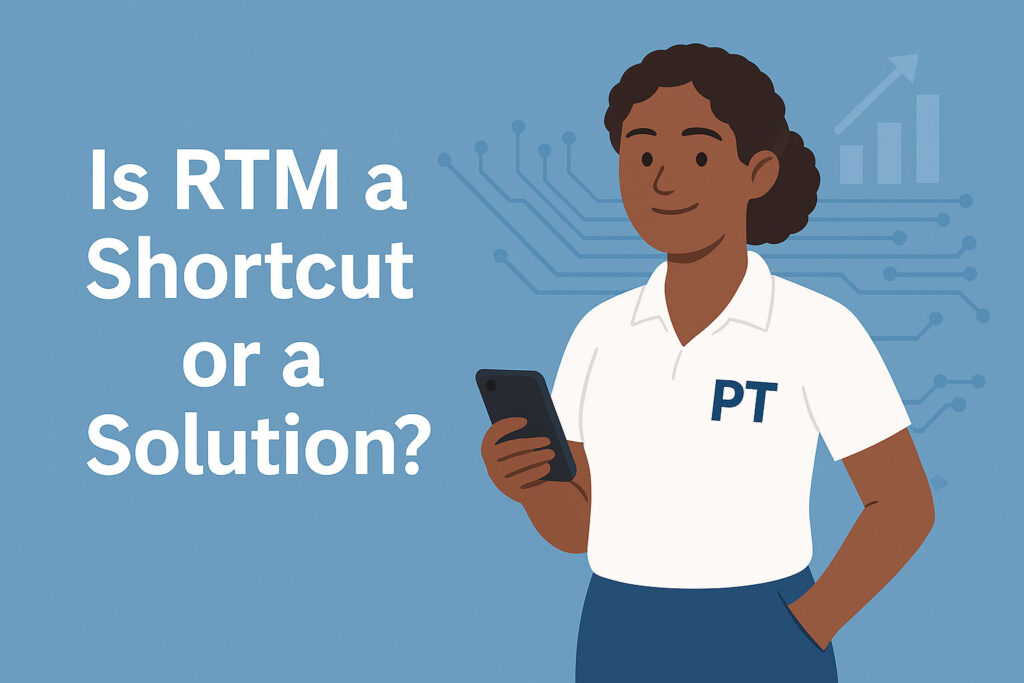Practice Management
Clayton W.
Is RTM Becoming a Shortcut or a Solution? What PT Clinics Need to Know
When a great tool is misused, trust and outcomes both suffer. Remote Therapeutic Monitoring (RTM) was supposed to be a game-changer. Used correctly, it extends care beyond the clinic, supports continuity of care, and helps therapists track meaningful progress between visits. But lately, RTM has come under fire. And not without reason.

In a widely discussed LinkedIn post, Paul Singh of StrataPT raised a red flag: too many clinics are treating RTM as a passive revenue tool instead of a purposeful extension of care. That distinction matters.
“When RTM and RPM are used as add-ons without clear integration, healthcare costs go up, but outcomes don’t improve.”
– Paul Singh
So let’s talk about what’s going wrong, what still works, and how clinics can course-correct before payers and regulators step in.
The Problem: RTM Is Being Used Without Clinical Intent
Alex Bendersky highlighted a pattern that many in the rehab space recognize. Certain operators are using RTM codes with little regard for clinical relevance or patient need.
“This practice invalidates what could be a valuable extension of MSK care.”
Julia Goodwin added that some clinics are generating codes from automated messages, with no therapist involvement or clinical oversight.
That’s not care. That’s billing strategy.
What RTM Was Designed to Do
RTM was created to fill a real need:
To track and support patients between visits, not to simply tack on extra codes.
As Matthew Jurek, DPT, CSCS, explained:
“The purpose of RTM is to deliver meaningful advice, grounded in data, and communicated by a clinician.”
That means:
- Monitoring home exercise adherence
- Checking in on symptoms and activity
- Proactively addressing setbacks before they lead to dropout
Used properly, RTM builds trust. It doesn’t just support care. It enhances it.
Why It’s Under Scrutiny
The more RTM is used to pad visit counts or productivity metrics, the more likely it is to attract audits and restrictions.
“If we lose sight of outcomes, we risk losing the trust that innovation depends on.”
– Paul Singh
As Kimberly Jimenez pointed out, payers have already responded to past abuse. RTM is starting to show similar signs, which could put its future at risk.
What Ethical Use of RTM Looks Like
Several voices in the thread shared how RTM can still be used ethically and effectively.
Here’s what that looks like:
- Codes should only be billed when a therapist is actively reviewing and acting on data.
- Remote check-ins should reduce unnecessary in-person visits, not prolong the billing cycle.
- RTM should support true hybrid care models, where digital tools extend — not replace — clinical engagement.
- The workflow should fit the patient and the provider, not the other way around.
“Shortcuts never work for long. Outcome-focused care is the right long-term solution.”
– Lily Belcak
Use the Tool With Purpose
RTM isn’t the problem. The way it’s being used is.
As with any tool in healthcare, intent matters. If we focus on billing over outcomes, we lose the opportunity to improve care and build patient trust.
Let’s keep RTM what it was meant to be: a smart, purposeful tool that supports better outcomes and more engaged patients.
Because when we lead with purpose instead of convenience, everyone wins.
Need help auditing your RTM workflow or scaling remote support that actually helps patients?
👉 OrthopedicMarketing.net is here to help.



